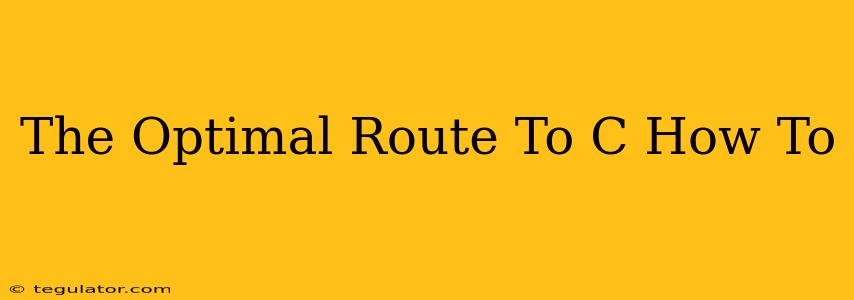So, you're ready to embark on the journey of learning C? Excellent choice! C is a powerful, foundational language that will open doors to systems programming, embedded systems, and much more. But navigating the learning process can feel overwhelming. This guide will map out the optimal route, ensuring a smooth and effective learning experience.
Laying the Foundation: Prerequisites
Before diving into the intricacies of C, let's ensure you have a solid base. While not strictly required, these elements will significantly ease your journey:
- Basic Programming Concepts: Familiarity with fundamental programming concepts like variables, data types (integers, floats, etc.), loops (for, while), conditional statements (if, else), and functions is hugely beneficial. Even a little exposure to another language like Python or JavaScript will give you a head start. You don't need mastery, just a general understanding.
- Understanding of Computer Architecture (Optional but Recommended): While not mandatory to start coding in C, grasping basic concepts of how computers work – memory, CPU, operating systems – will provide a deeper understanding of what your C code is actually doing. This is especially valuable if you aim for lower-level programming.
Choosing Your Weapons: Resources and Tools
The right tools can make all the difference. Here are some excellent resources to get started:
- A Good Textbook: Many excellent C programming textbooks are available. Look for one with clear explanations, plenty of examples, and exercises. A well-structured book provides a solid theoretical foundation.
- Online Courses: Platforms like Coursera, edX, and Udemy offer numerous C programming courses, catering to various skill levels. These courses provide structured learning with interactive elements and often include quizzes and projects.
- Interactive Tutorials: Websites dedicated to C programming often offer interactive tutorials, allowing you to learn by doing. These tutorials typically provide immediate feedback, making the learning process more engaging.
- A Powerful IDE (Integrated Development Environment): Choose a robust IDE like Code::Blocks, Eclipse, or Visual Studio Code. These environments provide code completion, debugging tools, and other features to streamline your coding process. Starting with a user-friendly IDE simplifies the initial learning curve.
Charting Your Course: A Step-by-Step Approach
Here's a suggested learning path:
1. Master the Basics:
- Data Types and Variables: Understand different data types (int, float, char, etc.) and how to declare and use variables.
- Operators: Grasp arithmetic, logical, and bitwise operators and their applications.
- Control Flow: Learn how to use
if-elsestatements,forloops,whileloops, andswitchstatements to control the flow of your programs. - Functions: Understand how to define and call functions to modularize your code.
2. Tackle Intermediate Concepts:
- Arrays and Pointers: This is where C gets really interesting (and potentially challenging). Mastering pointers is crucial for effective C programming. Take your time with this; it's a core concept.
- Strings: Learn how to work with strings in C. Remember, C strings are essentially character arrays.
- Structures and Unions: Understand how to create custom data types using structures and unions.
- File Handling: Learn how to read and write data to files.
3. Explore Advanced Topics:
- Dynamic Memory Allocation: Learn how to use
malloc,calloc,realloc, andfreeto manage memory dynamically. - Preprocessor Directives: Understand how preprocessor directives like
#include,#define, and#ifdefwork. - Standard Library Functions: Familiarize yourself with commonly used functions from the C standard library. The library provides a wide range of functionalities, saving you from writing everything from scratch.
Practice Makes Perfect: Projects and Exercises
The key to mastering C is consistent practice. Work through numerous exercises and tackle small projects. Start with simple programs and gradually increase the complexity. Some project ideas:
- A simple calculator: Perform basic arithmetic operations.
- A program to manage a list of students: Store and manipulate student data.
- A text-based adventure game: A fun way to practice control flow and user input.
Beyond the Basics: Where to Go Next
Once you've built a strong foundation in C, you can explore more advanced areas:
- Data Structures and Algorithms: Improve your programming skills by studying different data structures (linked lists, trees, graphs) and algorithms.
- Embedded Systems Programming: If you're interested in working with microcontrollers, learn how to program embedded systems in C.
- Systems Programming: Delve into the world of operating systems and kernel development.
Learning C is a journey, not a sprint. Be patient, persistent, and enjoy the process! With dedication and the right approach, you'll become proficient in this powerful language.

